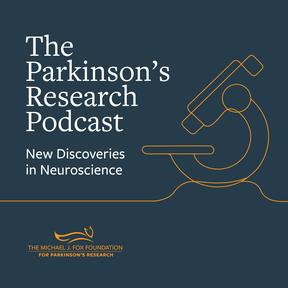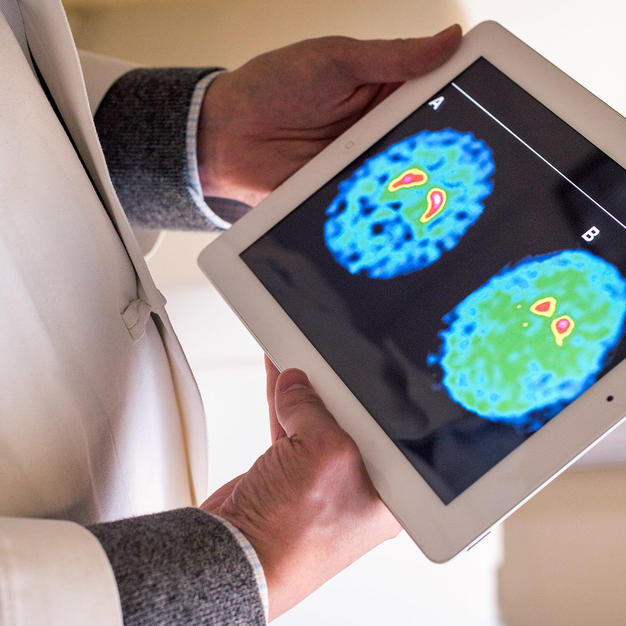In 2023, an international coalition of scientists led by The Michael J. Fox Foundation discovered a Parkinson's biomarker — a tool that can detect the earliest biological signs of the disease in living people.
What Is a Biomarker?
Friends of the Foundation break down key questions about the Parkinson's biomarker, including what it means for research moving forward and how our community helped us get here.

Researchers discovered this new tool by looking for abnormal alpha-synuclein, the protein that is a hallmark of Parkinson’s disease, in spinal fluid.
The presence of abnormal alpha-synuclein reveals the disease process that occurs with Parkinson's — making it a biomarker that indicates presence of the disease. And just like commonly known biomarkers such as cholesterol, the ability to detect it early, and measure it, will lead to improved understanding of Parkinson's, new treatments to halt the disease in its tracks and, eventually, a cure.

This monumental breakthrough opens the door to more effective clinical trials and the possibility of personalized care for each Parkinson’s patient. Your support will help us get there faster.
Since 2001, The Michael J. Fox Foundation has pushed the field to develop new and innovative biomarkers for Parkinson’s. This effort was kicked into overdrive in 2010 through the Foundation-led Parkinson’s Progression Markers Initiative (PPMI) study. After decades of research powered by thousands of study volunteers and millions in funding, the 2023 finding marks the most significant breakthrough in Parkinson’s research since the discovery of levodopa in 1967.
The biomarker tool can detect abnormal alpha-synuclein protein in the spinal fluid of people with the disease with 93 percent accuracy. This tool, called the alpha-synuclein seeding amplification assay (αSyn-SAA), looks specifically for misfolded and clumped alpha-synuclein protein, which damages neurons and causes the cell death that is linked to Parkinson’s disease.
How will the Parkinson's biomarker impact patient care?
While αSyn-SAA is now available through a doctor’s office, it doesn’t yet broadly change how doctors diagnose and treat PD. But it likely will in the future, especially as testing becomes simpler and easier to access. Hear from a movement disorder specialist about what this tool means for people with Parkinson’s today.
How will the Parkinson’s biomarker impact research?
Parkinson's is caused by loss of dopamine-producing cells in the brain. Ultimately, a treatment aimed at preventing or stopping dopamine cell death is the path to a cure. The discovery of the first Parkinson’s biomarker marks a critical inflection point for Parkinson’s research, especially in the search for therapies to slow, stop or even prevent disease.
The new tool is already making clinical trials cheaper, faster and more effective. It’s also changing how we think about the disease and its symptoms, paving the way for a more personalized approach to treatment. On the heels of the biomarker breakthrough, researchers proposed the first biological staging system for Parkinson’s, which is a framework for defining and staging PD based on its underlying biology. And in September 2024, the FDA issued a letter of support endorsing use of the biomarker in research and clinical trials.
Researchers are continuing to explore uses for αSyn-SAA as a tool to better understand the progression of the disease and its origins.
Where We’re Headed: The Search for Additional Parkinson's Biomarkers
Scientists are looking all over the body for more signs of disease presence and progression. The Michael J. Fox Foundation is funding biomarker research to improve the current tool and add new ones to our toolbox. The major avenues of pursuit include:
- Brain imaging — developing tools to visualize proteins linked to PD in the living brain
- Fluid or tissue sampling — testing levels of proteins or other markers in blood, spinal fluid (like the SAA test), urine or tissue
- Non-invasive tests — using technology to diagnose PD with, for example, eye tracking or to monitor progression with wearable devices
The more information we have about the biology underpinning the disease, the better (and earlier) we can intervene. For example, doctors routinely test blood pressure and cholesterol levels and use the results in concert to determine an individual’s risk of heart disease. We likely need to use a combination of biomarkers and clinical information over time to track an individual’s Parkinson’s risk and progression.
-

Episode 19: Current and Emerging Imaging Biomarkers for Diagnosis and Prognosis of PD and Atypical Parkinsonism with Antonio Strafella
-

-

-

Promising Results and Next Steps in the “Ken Griffin Alpha-synuclein Imaging Competition”

Support the Momentum
The discovery of a Parkinson’s biomarker has launched a new era in Parkinson's research and we can’t slow down now.

Volunteer for Research
Our most important partners in advancing research breakthroughs are people with Parkinson’s and their loved ones.